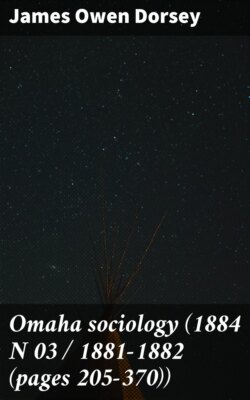Читать книгу Omaha sociology (1884 N 03 / 1881-1882 (pages 205-370)) - James Owen Dorsey - Страница 3
На сайте Литреса книга снята с продажи.
ОглавлениеCHAPTER I.
INTRODUCTION.
Table of Contents
§ 1. The Omaha Indians belong to the ₵egiha group of the Siouan family. The ₵egiha group may be divided into the Omaha-₵egiha and the Kwapa-₵egiha. In the former are four tribes, speaking three dialects, while the latter consists of one tribe, the Kwapas. The dialects are as follows: Pañka, spoken by the Ponkas and Omahas; Waᴐaᴐe, the Osage dialect; [K]anze, that of the Kansas or Kaws, closely related to the Waᴐaᴐe; and Ugaqpa, or Kwapa.
§ 2. ₵egiha means, "Belonging to the people of this land," and answers to the Oto "[T]ᴐiwere," and the Iowa "[T]ᴐeʞiwere." Mr. Joseph La Flèche, who was formerly a head chief of the Omahas, also said that ₵egiha was about equivalent to "Dakota." When an Omaha was challenged in the dark, when on his own land, he generally replied, "I am a ₵egiha." So did a Ponka reply, under similar circumstances, when on his own land. But when challenged in the dark, when away from home, he was obliged to give the name of his tribe, saying, "I am an Omaha," or, "I am a Ponka," as the case might be.
§ 3. The real name of the Omahas is "Umanhan." It is explained by a tradition obtained from a few members of the tribe. When the ancestors of the Omahas, Ponkas, Osages, and several other cognate tribes traveled down the Ohio to its mouth, they separated on reaching the Mississippi. Some went up the river, hence the name Umanhan, from ʞímanhan, "to go against the wind or stream." The rest went down the river, hence the name Ugáqpa or Kwápa, from ugáqpa or ugáha, "to float down the stream."
EARLY MIGRATIONS OF THE ₵EGIHA TRIBES.
Table of Contents
The tribes that went up the Mississippi were the Omahas, Ponkas, Osages, and Kansas. Some of the Omahas remember a tradition that their ancestors once dwelt at the place where Saint Louis now stands; and the Osages and Kansas say that they were all one people, inhabiting an extensive peninsula, on the Missouri River.
On this peninsula was a high mountain, which the Kansas called Man-daqpaye and Tce-dŭñga-ajabe; the corresponding Osage name being Man-ʇaqpa¢ě.1
Subsequently, these tribes ranged through a territory, including Osage, Gasconade, and other adjacent counties of the State of Missouri, perhaps most of the country lying between the Mississippi and the Osage Rivers. The Iowas were near them; but the Omahas say that the Otos and Missouris were not known to them. The Iowa chiefs, however, have a tradition that the Otos were their kindred, and that both tribes, as well as the Omahas and Ponkas, were originally Winnebagos. A recent study of the dialects of the Osages, Kansas, and Kwapas discloses remarkable similarities which strengthen the supposition that the Iowas and Otos, as well as the Missouris, were of one stock.
At the mouth of the Osage River the final separation occurred. The Omahas and Ponkas crossed the Missouri and, accompanied by the Iowas, proceeded by degrees through Missouri, Iowa, and Minnesota, till they reached the neighborhood of the Red Pipestone quarry. This must have taken many years, as their course was marked by a succession of villages, consisting of earth lodges.
Thence they journeyed towards the Big Sioux River, where they made a fort. They remained in that country a long time, making earth lodges and cultivating fields. Game abounded. At that time the Yanktons dwelt in a densely wooded country near the head of the Mississippi; hence the Omahas called them, in those days, "Jan´aʇa ni´kacinga, The people who dwelt in the woods." After that the Yanktons removed and became known as Yanktons. By and by the Dakotas made war on the three tribes, and many Omahas were killed by them. So at last the three tribes went west and southwest to a lake near the head of Choteau Creek, Dakota Territory, now known as Lake Andes (?). There they cut the sacred pole (see §§ 36 and 153), and assigned to each gens and subgens its peculiar customs, such as the sacred pipe, sacred tents, and the taboos. There were a great many gentes in each tribe at that time, far more than they have at present; and these gentes were in existence long before they cut the sacred pole.
After leaving the lake, known as "Waq¢éxe gasai´ ¢an, Where they cut the sacred pole," they traveled up the Missouri River till they arrived at Ni-úgacúde, White Earth River. They crossed the Missouri, above this stream, and occupied the country between the Missouri and the Black Hills, though they did not go to the Black Hills.2 After awhile, they turned down stream, and kept together till they reached the mouth of the Niobrara, where the Ponkas stopped. The Omahas and Iowas continued their journey till they reached Bow Creek, Nebraska, where the Omahas made their village, the Iowas going beyond till they reached Ionia Creek, where they made a village on the east bank of the stream, near its mouth, and not far from the site of the present town of Ponca.
